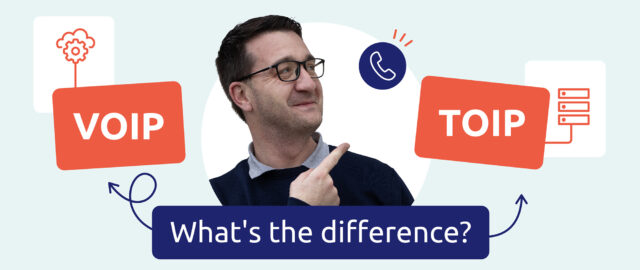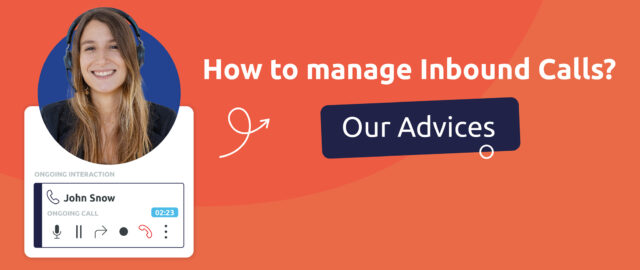The “old school” technique, but not outdated
The technique most widely used by call centers consists in setting up an optimized Interactive Voice Response (IVR) that lists the customer’s choices and attaches a group of agents to each choice. This method has been widely criticized, even caricatured. However, it does not lack merit if you know how to limit yourself to 1 or 2 voice menus, each presenting three or four possible choices. Beyond that, the customer feels lost or trapped, especially if he has the impression that none of the choices offered correspond to their request…
From our point of view, this type of call center routing has a double advantage: first, it empowers the customer to choose during each call which avoiding locking them into a call route that no longer corresponds to their case. For example, this prevents calls from a customer previously identified as “at risk” from being systematically directed to the “loyalty” department, whereas this customer may very well have another reason for calling: for example, they may have encountered a technical problem with the equipment purchased, wants to report a change of address, or change the appointment date with a technician. The second advantage, if the proposed choices are explicit and relevant, is of course the pre-qualification of the vast majority of calls. On the one hand, this allows for specialized agent groups and, on the other, the ability to analyze incoming traffic posteriori to discover the patterns for calls which can feed operational strategy and support wider initiatives to tackle the root of problems.
When used properly, IVR remains a good strategy, especially if you have a telephony solution that allows you to modify your scenarios and menus independently – that is, without having to use a technical profile each time you want to change a statement or restructure your customer journey.
The technique that is (re)gaining ground
This is voice recognition: instead of making choices by pressing the keys on his phone, the voice server asks the customer to state his need orally and directs the call to the appropriate group of agents. In the 1990s, there was a certain enthusiasm in large service companies for this method, which was considered a priori less tedious for customers than traditional IVRs. Except that speech recognition techniques were not very effective, so customer statements were often not understood, even when they were restricted to a list of words previously listed by the IVR (to pay your bill, say “pay”, etc.)
With older technologies, for this device to work, it was necessary either to drastically limit the number of possible items or to build vast phonetic libraries considering the accents and multiple possible deformations of the items. For example, in the travel industry, if you ask the customer to state the name of his airline in order to route their call to the airline’s load center, you are exposed to a high error rate, as customers may not have known the exact name of their company or pronounced it with an unlisted accent… The result: frustration for the customer when they are told “I didn’t understand” by a robotic voice, difficulty integrating new variables and variations into the library and, ultimately, inefficient call routing…
Since then, voice recognition has made enormous progress and this voice-based call routing technique, which we previously thought would disappear, has seen a real rebound in the last year or two with voicebots. Theoretically, voicebots are based on an artificial intelligence engine that “understands” natural language. But let’s not delude ourselves about the real mechanisms: most actors who succeed in understanding a broad spectrum of natural language statements and formulations actually go through the text, quite simply because text is easier to analyze than voice and there are many more extensive textual corpuses. Voice recognition is therefore more like “speech-to-text” for the analysis of requests and “text-to-speech” for the steps of confirming the correct understanding of these requests.
The speed of the motors makes it transparent to the user, provided that the learning curve of a robot of this type is considered: it is necessary to educate it, feed it, analyse its errors, “show” it where it has made mistakes so that it does not make the same mistakes… In short, it takes a lot of human work and resources before reaching a satisfactory level of efficiency from an operational point of view.
Fully automated level 1 services?
If we look at the companies that are turning to this type of solution, we see that they are less interested in using the voicebot to route calls to advisors than in fully automating certain services where the human contribution is low. For example, if the customer wishes to pay an invoice by phone, once the robot understands his request, the call will be redirected to a secure card payment centre rather than to an agent. If the call concerns the return of a product, the voicebot can answer “I’ll send you an SMS with the procedure to follow”.
In other words, it is a matter of creating a first level of service “in multi-channel self-service” for standard and repetitive questions, which relieves customer service congestion. Requests not included or not satisfied via the bot are then distributed to agents who provide a second level of service. Not all customers may appreciate this type of “humane” organization. That is why we recommend that users of our solutions always allow their customers to be connected to a person, whether via a voicebot or a classic IVR.
The way of the future: intelligent routing based on customer knowledge
New strategies allow you to bypass the IVR step by using the caller’s number and customer knowledge to intelligently route each call to the right person. The implementation of an intelligent routing strategy is based on communication between the telephony solution and third-party systems storing customer knowledge, primarily CRM systems. The caller’s number is generally the key to automatically searching within the CRM database for information related to this customer and directing the call directly to the advisor to whom it is attached because of its status, geographical location, language used, history or any other criteria in the CRM.
The first advantage of this call routing technique is that the customer has no action/manipulation to perform, the second is that the advisor who answers him has all the necessary information to recognize him and deliver a much more personalized service. The third advantage is the possibility of using the various CRM fields to prioritize incoming calls according to the importance of the customer for the company or the urgency of its request. For example, in B2C, a operator within the tourism industry may decide that any customer with a departure within 24 hours has priority in queues and even more so if his departure is within 12 hours, the reason for the call having a high probability of being urgent. In B2B, routing will be primarily to the customer’s dedicated contact person, with, in the event of unavailability of the customer, overflow strategies to agents from another platform or contact centre with the required skills.
The fourth advantage, at least for users of the Diabolocom solution interfaced with a CRM, is to be able to implement and develop such routing scenarios, mixing customer knowledge and agent skills, very quickly, according to the needs of the activity – all without requiring a technical representative to implement the solution or writing a line of code. Those who still work with older telephony systems – where any change requires days or even weeks of delay – immediately understand that this autonomy and the resulting responsiveness are not the least of the advantages… An additional reason to switch to an open telephony system (CRM, voicebot, switch to other contact channels) that gives them the concrete means to reconcile maximizing processing rates, customizing the experience on the voice channel and high customer satisfaction level!
Curious to know more about Diabolocom?




